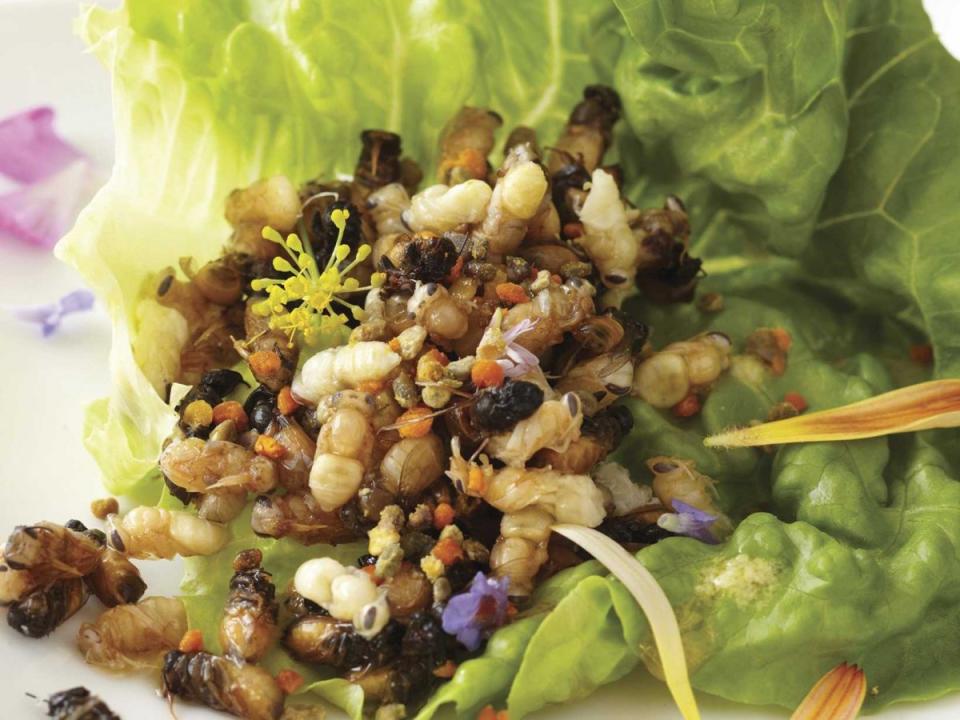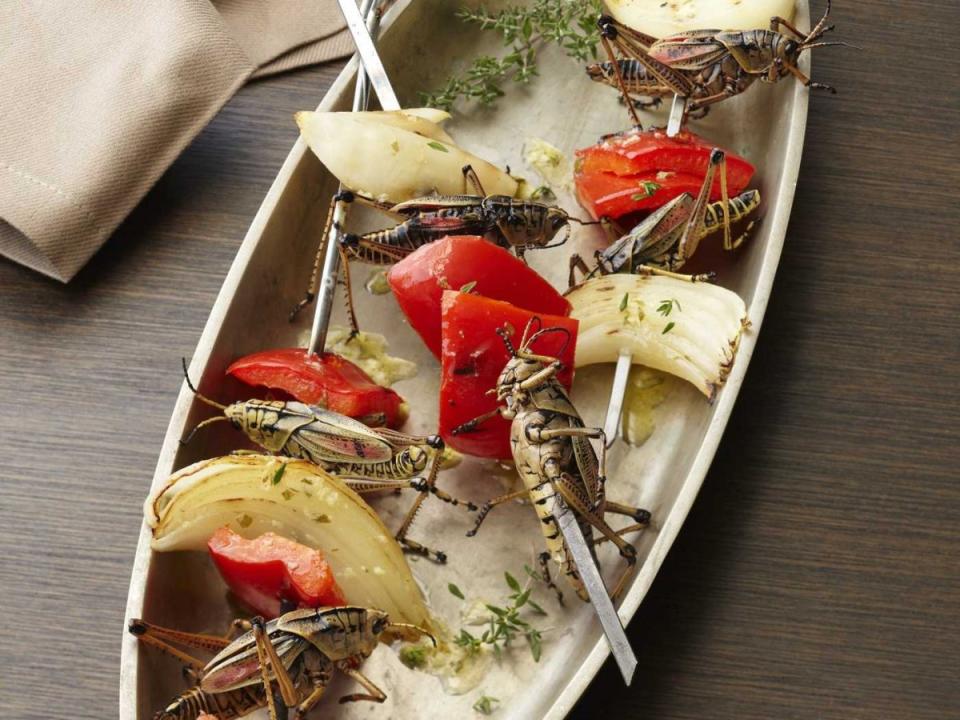The Author Of The 'Eat-A-Bug' Cookbook Explains How To Make Tarantulas Taste Good
Chugrad McAndrews
is a self-described naturalist who's made a career of writing about and eating bugs. His famed "Eat-A-Bug Cookbook" is celebrating its 15th anniversary this year, and now Gordon has released a revised and updated version , complete with new recipes and beautiful photos of dishes that actually make bugs look delicious.
Gordon was working on his 1996 book "The Compleat Cockroach" when he first realized how truly edible cockroaches are — they're full of protein and, as most New Yorkers know, are especially crunchy, he said in an interview with Business Insider.
Gordon soon began working on a cookbook that would include recipes for all bugs, not just roaches. It was published two years later.
These days, Gordon spends much of his time traveling around the country cooking bugs for daring audiences of hundreds (y ou can check his schedule here).
He's been featured in Time and The Wall Street Journal , and he's been a guest on Late Night with Conan O'Brien, ABC's Nightline and The View . But perhaps Gordon's most impressive feat is making insect dishes seem attractive and even appetizing.
The bees in his Three Bee Salad could almost be mistaken for beans. Of course, they're not, and most people wouldn't dream of topping their salad with insects, but Gordon is quick to point out just how silly that is.
"80% of the world eats bugs in some form," Gordon said. "We're really the weirdos because we don't eat bugs. Western ideas about taste are pretty narrowly-defined."
Besides being nutritious, bugs are a sustainable form of food. In May, the UN released a report urging people around the world to eat more bugs, as doing so might help to fight world hunger.
For beginner bug-eaters, Gordon recommended crickets, which he said are crunchy, light, and easy to find at pet stores. He himself buys them by the thousands from a supplier in Louisiana and then freezes them, "so they don't hop around in the saucepan."
Wax worms, his personal favorite, spend their lives eating honey and as a result they taste surprisingly sweet. You can buy them cheap at bait and tackle shops. When they're cooked into his white chocolate and wax worm cookies, he told me, they taste "a little bit like pistachio nuts."
But what about the stuff that's harder for people to swallow (in more ways than one), like tarantulas? Gordon's solution: deep-fry them.
"I singe off the hairs, dip them in tempura batter and then deep-fry them," he laughed. "I always say I'll eat anything deep-fried!"
Beneath the surface, the spiders have a unique texture. "Tarantulas have a body armor that's very pliable," Gordon explained. "Their legs are full of this long white muscle, and people are always surprised by how chewy they are."
When I brought up the hordes of cicadas that blanketed much of the East Coast during May and June, Gordon had a lot to say.
"Cicadas are full of vitamins, minerals and proteins," he told me. "The best time to get one is just after it's emerged from the ground but before it's begun to grow a hard shell. Some people say they taste like soft-shell crab." His book includes a recipe for a cicada-and-artichoke-topped pizza that's called Piz-zz-zz-za.
As far-out as his recipes may be, Gordon himself is very down-to-earth, especially when it comes to his expectations for bugs as food.
"Do I expect the whole world to start eating bugs? No, but I want to make people question their ideas about what's acceptable to eat and where those ideas come from," he said. "We eat chicken eggs, and that's kind of weird when you really think about it."
He may be onto something.
Gordon shared three of his bug recipes with us. The rest are in his book, available on Amazon.
Three Bee Salad (yields 4 servings)

Chugrad McAndrews
Three Bee Salad (recipe below)
1/2 cup (about 40) frozen adult bees; 1/2 cup (about 60) frozen bee pupae; 1/2 cup (about 60) frozen bee larvae; 2 tablespoons red wine vinegar; 6 tablespoons olive oil; 1 teaspoon Dijon mustard; Salt and freshly ground pepper to taste; 1 ounce bee pollen granules; Lettuce for serving; Nasturtium petals or other edible flowers for serving.
1. Bring two quarts of lightly salted water to a boil. Add the adult honeybees and return to boil for 1 minute. Using a slotted spoon, remove the bees from the water. Pat dry with paper towels and allow to cool.
2. To the same water, add the honeybee pupae. Repeat the procedure for cooking the adult bees (but watch how you pat these little guys with the paper towels!), also allowing the pupae to cool.
3. Repeat the same process with the honeybee larvae.
4. In a large bowl, combine the vinegar, oil, mustard, and salt and pepper to taste. Add the cooked adult bees, followed by the pupae, then the larvae.
5. Immediately before serving, add the bee pollen granules, stirring the mixture to ensure that the granules are evenly distributed.
6. Serve on a bed of lettuce, decorated with the nasturtium petals, a bee-utiful touch for this bee-atific dish.
Sheesh! Kabobs (yields 6 servings)

Chugrad McAndrews
Grasshopper "Sheesh! Kabobs" (recipe below)
12 frozen katydids, grasshoppers, or other large-bodied Orthoptera, thawed; 1 red bell pepper, cut into 1 1 / 2 -inch chunks; 1 small yellow onion, cut into 8 wedges
Marinade
1/2 cup fresh lemon juice; 1 tablespoon olive oil; 1 teaspoon honey; 1/2 teaspoon freshly grated ginger; 1 tablespoon Dijon mustard; 2 tablespoons minced fresh herbs, such as parsley, mint, thyme, and tarragon; 1/4 teaspoon salt; Pinch of freshly ground pepper.
1. Mix all ingredients for the marinade in a nonreactive baking dish. Add the katydids, cover, and marinate in the refrigerator overnight.
2. When ready to cook, remove the katydids from the marinade and pat dry. Assemble the kabobs by alternately skewering the insects, bell pepper, and onion wedges to create a visually interesting lineup.
3. Brush the grill lightly with olive oil. Cook the kabobs 2 or 3 inches above the fire, turning them every two or three minutes and basting them with additional olive oil as required. The exact cooking time will vary, depending on your grill and the type of insects used. However, the kabobs should cook for no longer than 8 or 9 minutes.
Deep-Fried Tarantula Spider (yields 4 servings)

Chugrad McAndrews
Deep-Fried Tarantula Spider (recipe below)
2 cups canola or vegetable oil; 2 frozen adult Texas brown, Chilean rose, or similar-sized tarantulas, thawed; 1 cup tempura batter (scroll down); 1 teaspoon smoked paprika.
1. In a deep saucepan or deep-fat fryer, heat the oil to 350°F.
2. With a sharp knife, sever and discard the abdomens from the two tarantulas. Singe off any of the spider’s body hairs with a crème brûlée torch or butane cigarette lighter.
3. Dip each spider into the tempura batter to thoroughly coat. Use a slotted spoon or your hands to make sure each spider is spread-eagled (so to speak) and not clumped together before dropping it into the hot oil.
4. Deep-fry the spiders, one at a time, until the batter is lightly browned, about 1 minute. Remove each spider from the oil and place it on paper towels to drain.
5. Use a sharp knife to cut each spider in two lengthwise. Sprinkle with the paprika and serve. Encourage your guests to try the legs first and, if still hungry, to nibble on the meat-filled mesothorax, avoiding the spider’s paired fangs, which are tucked away in the head region.
Tempura Batter
1 medium egg; 1/2 cup cold water; 1/2 cup all-purpose flour; 1/2 teaspoon baking soda.
1. To make the batter, beat the egg in a small mixing bowl until smooth. Slowly add the cold water, continuing to beat until evenly mixed. Add the flour and baking soda and beat gently until combined; the batter should be a bit lumpy.
2. Let the batter sit at room temperature while heating the oil.
Recipes reprinted with permission from The Eat-A-Bug Cookbook, Revised by David George Gordon (Ten Speed Press, © 2013). Photo Credit: Chugrad McAndrews.
More From Business Insider


